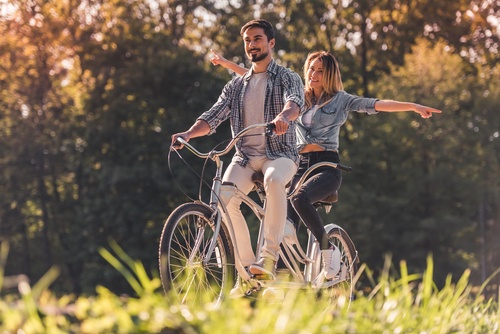According to research from the Official Charts Company and the BPI, recorded music consumption in the UK is constantly growing, with album equivalent sales (AES) for the first half of 2023 reaching more than 89.7 million. Music is an integral part of everyday life for many and can enhance the experience of otherwise mundane or difficult activities.
If you haven’t felt like your performance when cycling has been up to snuff recently, listening to music while on your ride could help give you a boost.
Ben Mercer, road bike enthusiast and director at Leisure Lakes Bikes, says:
“Whenever I’m on my bike, I’ve always got something playing to keep my pace consistent. It’s vastly underestimated how much it can affect your rides, and for those looking for ways of improving the time spent on your bike, music could be your answer!”
He has even provided a beginner’s guide to accelerating your cycling journeys with a pair of headphones and the right music, including looking into some of the science behind it.
Can music really have an impact?
Many studies on the effect of music on performance have been conducted over the years and one of the leading researchers on the subject, Dr. Costas Karageorghis of Brunel University London, referred to it as a type of legal performance-enhancing drug. Quite the endorsement for building a riding playlist!
Further research has found correlations between exertion and tempo of the music playing thanks to a study done by the Research Institute for Sport and Exercise Sciences at Liverpool John Moores University. It found that music with an increased tempo could increase the distance covered, power and pedal cadence by as much as 3.5%.
While that number might not seem high, over the course of a ride it could have a huge impact on how much further you can take your journey as it would scale according to your goal distance and your preferred musical genre. Another study from the University of Edinburgh found that mental fatigue can be improved moderately using self-selected motivational music.
The best headphones for cycling
Some countries in Europe such as France have laws which prevent you from using headphones while cycling due to safety concerns, but there are no official regulations that block you from listening to music while riding in the UK. Safety and awareness are something that you should absolutely consider when looking at headphone options, as you don’t want to put yourself in danger by cutting out surrounding noise.
The best options for headphones tend to be wireless earbuds. They’re small enough that they can fit in your ears underneath your helmet, meaning that you can keep yourself protected. Popular options for these vary depending on the price you’re willing to pay, but there are great all-rounder options like Apple’s AirPods and Samsung Galaxy Buds Pro which double as great workout and lifestyle earbuds.
Bone-conduction headphones are a fantastic alternative to the traditional in-, on-, and over-ear headphones on the market, as they transfer the sound of your music through your zygomatic arch, also known as the bone on the outside of your ear. These keep your inner ear open so you can take in the sounds of your environment and keep you much safer.
Finding the right sounds for you
This is arguably the most fun bit of cycling to music, building your perfect playlist. You can let your creative side take the wheel (or in this case the handlebars), and curate all your favourite tunes that get your blood pumping for when you’re on your bike.
Popular energy drinks company Red Bull has even curated a biking playlist on Spotify with 100 tracks listed, which you can check out if you need some inspiration for making yours. You can use the research that’s been done to help influence the tracks you incorporate into it. Looking to soundtrack a relaxed afternoon bike ride through the park or through the scenic countryside? Tracks with slower beats per minute (BPMs) and a more soothing rhythm can help to keep your pace so you’re not overexerting yourself.
Whereas, if you’re looking to boost your personal best when tearing through your routes (or even just for a faster commute), loading it up with faster and more upbeat music could help you maintain your speed while cycling.


No comments yet